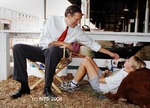Stories To Tell Books BLOG
Filtering by Category: Incorporating Photographs and Illustrations
Finding Meaning in Family Photographs
Biff Barnes
Family Letter Collections Make Wonderful Books
Biff Barnes
How Photos Help to Tell a Story
Biff Barnes
How Do I Find an Illustrator for My Self Published Children’s Book?
Biff Barnes
Photos and Storytelling
Biff Barnes
Labor Day Examples of Using Photos to Illustrate Text
Biff Barnes
Finding Photos for Your Memoir or Family History Book
Biff Barnes
Identifying People in Family Photo Albums
Biff Barnes
The Photo Detective
Biff Barnes
Photographers, You’re Going To Love This
Nan Barnes
What if you could reinvent the camera? Just as all our technological tools are moving toward miniaturization and wireless connections, cameras are undergoing a makeover. Photography designers Artefact have developed the prototype, the WVIL, which stands for "Wireless Viewfinder Interchangeable Lens.”

The whole idea is that in current camera design, the viewfinder is shackled to the lens. What is the lens was in one place, but the viewfinder and controls were somewhere else, say on your computer or an iphone-type console? You could wireless adjust the lens through software, making the kind of rapid, minute calibrations that our clumsy fingers often fail to achieve.
But wait, there’s more! Why just one lens? What if you could position multiple lenses around a subject, and control them all wirelessly? Photography is then transformed to a simultaneous input 3D art.
To learn more, check out this article in Fast Company. There's a fascinating video, too. “Artefact claims that the WVIL concept is less about redesigning the digital camera as it is about redesigning digital photography itself.
"It's about defining a platform for innovation in both hardware and software -- a camera operating system," Ronning says. "We've seen the effect that iOS had on phones. Now think of what effect a camera OS could have for photography."
I can imagine, and like the fanatical iphone buyers, I would stand in line all night to buy this.
More Sources of Photos for Your Family History Book
Biff Barnes
Images of Ancestors for Your Family History Book
Biff Barnes
The Pros and Cons of Photo Scanning Services
Biff Barnes
You find a nice quick, easy, low cost photo scanning service online and ship them the photos you want to use in your family history book. They come back on a CD which you forward to your book designer. The designer tells you that some or all of the photos will need to be rescanned. Whoa! What happened?
Shipping your photos off to an online scanning service is similar to the inexpensive service provided at Costco. For purposes of this post we’ll look at Scan My Photos International of Irvine, California, a large online scanning service. Their services are fairly typical. (There’s a link to their website at the end of the post.) Because all photos are scanned at just 300 DPI, this is a limited, one-size-fits-all solution. What does that mean for authors?
The service will probably work fine for fresh, modern prints, but they are often inadequate for older, more precious pictures. First, these services usually use a sheet feed scanner which feeds multiple pictures through the scanner at the same time. If any of the photos are delicate, as many old photos are, this can be dangerous. Older photos should be hand scanned on a flat-bed scanner which will not stress the photo in any way.
When these services scan at a resolution of 300 DPI, this is the minimum acceptable size DPI for book printers. This is important when you have a smaller photo you would like to enlarge in your book. To enlarge while maintaining image quality, the initial scan must be at a higher resolution. For example, if the photo is 2” X 4” and you wish to blow it up to 4” X 8”, it should be scanned at a resolution of at least 600 DPI. Generally it’s a good idea to scan at the highest possible resolution. Scanning services can be an acceptable alternative for scanning slides. Most people don’t have a slide rack for their scanner. When scanning slides, the scanning services offer a range of resolution choices and price points, because they anticipate that the small images will be blown up.
 Scanning services appear attractive both for convenience and their relatively low prices. They are handy for photos that will be shared via the web, as a shortcut to get your prints into a digital format.
Scanning services appear attractive both for convenience and their relatively low prices. They are handy for photos that will be shared via the web, as a shortcut to get your prints into a digital format.
However, books require the highest quality images, as they will be printed at high resolutions. If you are scanning photos to be reproduced in a book you will be better served to “hand scan” them, or to get some else with a good scanner and some experience to do it for you. Precious older photos should be hand scanned on a flatbed scanner to prevent bending. The scanner settings can be adjusted specifically to the size and condition of the original. A good scan is the first part of image processing; with the proper settings, it is possible to achieve better corrections to be made in Photoshop at the next step.
A word of caution as you prepare your family photographs for publication in your book. Realize that all photo scans are not the same. Low-end scanning services are fine for the web; but not for book design. Higher resolutions are needed to reproduce well you’re your book is printed – something you cannot see on your low-resolution computer screen. Even the most humble scanner today will scan at 1200 DPI. Why shortchange the future, when your grandchildren will be viewing images at even higher resolutions. With scanning, bigger is always better.
Click here to visit the Scan My Photos International site.
A Question for Family Historians: Do Your Images Lead to Stories?
Biff Barnes
As you plan and organize your family history of memoir you should carefully review the photographs and images like documents and letters that you have. When you do you face a potential fork in the road. There are two ways you can proceed. Ask yourself, “Do I want my images to be the primary organizing principle to guide the narrative, or do the stories come first, with images supplementing my stories?”
When you consider the stories and images you have, you may decide to employ pictorial storytelling. Think about magazine like Life and Look or even Sports Illustrated, which used vivid pictures to tell a story. Text was used to supplement and explain the images. Or think about documentary photography like Dorthea Lange’ iconic depression photos which capture a time and place.

To create a pictorial history, choose the images first, and eliminate stories that are not tied directly to the illustrations.
When choosing your images consider the:
- The physical quality of the images. Are the photos faded, torn or scratched?
- The vividness of the story told by the photograph. Is it interesting enough?
Choose photographs that:
- Evoke laughter or cause emotion
- Are candid and show character

- Show stages of life; such as pictures of the same person taken years apart
- Are action shots; in general they’re more interesting than posed photos

- Are close-ups rather than long distance shots

- Are horizontal rather than vertical; these usually make better illustrations.
Documents tell important family stories. Including scanned images of old letters, diaries, birth or death records, property records, military records, marriage certificates and wills can add to the stories told by your photo collection.

A Graphic Approach to Family History
Biff Barnes
Family historians often find themselves awash in a flood of factual data gathered from their genealogical research. How should you present the facts in a book? More importantly how can you make them lively and interesting when you do? Fast Company Magazine’s online site offers a feature called Infographic of the Day. Yesterday’s suggested an approach to presenting biographical and historical facts that might be useful to a family historian.
 One page of Nicholas Felton's Timeline. Others focus on other stages of his father's life.
One page of Nicholas Felton's Timeline. Others focus on other stages of his father's life.
The feature spotlights a project by award-winning New York graphic designer Nicholas Felton. In 2005 Felton began creating a graphical Annual Report reports in which he displays data compiled from his everyday activities throughout the year using ingenious charts, diagrams and maps. Says Fast Company, “For 2010, he's created a masterpiece. Instead of looking at his own life, he's captured the entire life of his father, Gunter, who passed last September.”
“Gunter worked as an elevator engineer and settled in California, which in all honesty sounds pretty structured and even, perhaps, boring. In actuality, Gunter was a fascinating man who led an unbelievably textured and rich life: Here was a guy who was born into Nazi Germany, was bombed by Germans during World War II, traveled to 48 countries, met the Black Panther co-founder Bobby Seale, and in old age practiced Tai Chi and saw Willie Nelson play with the Yamato Drummers.”
 Nicholas Felton
Nicholas Felton
Felton’s tribute to his father is a long way from the rather mundane family group sheets, pedigree charts and timelines that appear in family histories. True, he does have a family tree graphic and several timeline pages documenting his father’s life. But vibrant color, dramatic typography, and photo inserts transform these often staid items. He uses atlases to show his fathers residences, socializing and travel. Felton even includes a bar graph of books his father read categorized by genre and an electrocardiogram. These facts jump off the page and Gunter Felton comes to life in his son’s tribute.
Take a look! While you might not have Felton’s graphic design skills – I certainly don’t – you may get some ideas of how you can enrich your family history book by finding unique ways to present your facts about your ancestors.
Click here to visit Fast Company’s Infographics of the Day: A Son Honors His Father’s Life with a Masterpiece
Photo Choices in Your Family History Book
Biff Barnes
Have you ever watched a person look through a book they’ve picked up for the first time? If it has pictures, you can bet that’s where they’ll stop to take a look. That’s great news for family historians who have photographs to use in creating an illustrated book. Good pictures will make the book much more visually attractive, especially for younger readers who are growing up in a digital age.
To gain maximum advantage from your photos there are some important choices to make:
- Which photos will be featured? After reviewing your photos decide on 10-15 you think are excellent. The two best can be used on the front and back covers. Others can be displayed throughout the book as full pages (or significantly enlarged if the original is too small).
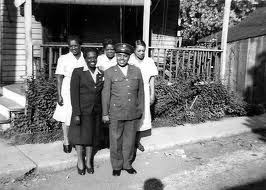
- If you don’t have many photos to use in illustrating your book, there is an alternative. Scanned family documents or photos of the time and place where ancestors lived, which can often be found by consulting local libraries, historical or genealogical societies, can give a sense of the lives your ancestors lived.
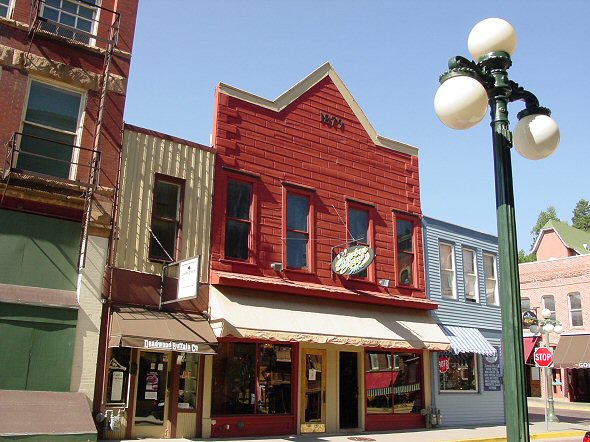
- There are a number of considerations in placing photographs. When possible, locate photos to accompany the text describing people or events in the picture. It is often wise to group photos of the same branch of the family tree to accompany their stories. However, not every image is, or must be so literally connected to your stories. To include more loosely related photos, you can group them together or place them between chapters. You can place up to a dozen photos on a page, but you may want to limit groupings to two to four photos so that they are bigger for better visual effect. We don’t recommend photo collages because they are often difficult for the reader to comprehend.
- Consider whether the image needs identification (who, what, when, where, why, how). Not every photo needs a caption, and documents often speak for themselves. Consider grouping pictures without captions in some sections of your book. Self explanatory photos, such as multiple images of the same person, are better off without a caption.
- Graphics like timelines and charts often benefit from effective use of photos. For example adding wedding pictures and fiftieth anniversary photos to a timeline can bring it to life. Thumbnail photos of heads of different branches of the family will bring a family group sheet will make it more interesting.
Identifying People in Old Family Photographs
Biff Barnes
Are you a mystery fan? I am. I love to watch detectives on the trail of clues, unraveling the past before my eyes.
Old family photos can offer the mystery-lovers among us a chance to become the detective. We’ve all got at least a few of those family photos that are interesting and probably important, but they feature people we simply can’t identify. It’s frustrating, but don’t throw the photos back into a box and bury them back in the garage. Here are some tools to help you discover your mysterious ancestors.
Kimberly Powell on About.com offers 5 Steps for Identifying People in Old Family Photographs. Her suggestions:
- Identify the Type of Photograph – Daguerreotypes were popular from 1839-1870, Cabinet Cards from 1866-1906, and no Polaroid photo could have been taken before 1948 (when the Polaroid camera was invented).
- Who Was the Photographer? – Check the front, back and frame or cover of the photo for the photographer’s name and possibly location. Local city directories, libraries, and historical or genealogical societies can help you track when the photographer was in business.
- Check Out the Scene or Setting – Clues to the time or location may appear when the family is posed in front of the family automobile or home. The Family Chronicles site on Dating Old Photographs suggests that it is often possible to establish the date by carefully comparing with other pictures of known date. For example, note details in the painted canvas background used for a studio shot. The drapes or woodwork in the scene may be clues to the photo’s date.
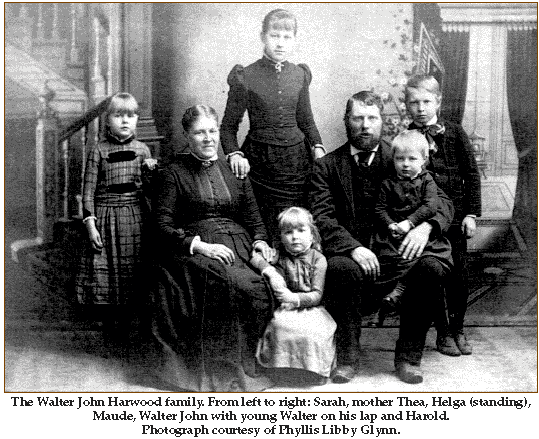
Visit Family Chronicles Dating Old Photographs to see how to date this photo.
- Focus on Clothing or Hairstyle – The Costume Detective website helps you to analyze costumes, fashion, hats, and jewelry to achieve a date within five years of the date the photo was taken. The Costumer’s Manifesto site offers numerous links for dating old family photographs, using fashion history and styles of photo-mounts. It promises, “These links are provided so you can teach yourself to do this for yourself.”
 Visit The Costume Detective to see how to date this photo.
Visit The Costume Detective to see how to date this photo.
- Match Up the Clues with Your Knowledge of Family History – Once you’ve identified the time and place of the photo, use your knowledge of ancestors to begin trying to identify who is in the picture.
Click here to read Kimberly Powell’s 5 Steps for Identifying People in Old Family Photographs
Click here to visit Family Chronicle’s Dating Old Photographs
Click here to visit the Costume Detective
Click here visit the Costumer’s Manifesto
How to Digitize Your Family History
Biff Barnes
Got questions about digitizing your family history research?
Make it Digital available on the website of Digital New Zealand has answers. “The Make it Digital approach is to identify elements of good practice for digital content creation.”
The site offers guides to digitizing documents, photographs, audio and video. There are a series of Guides to various aspects of the process of creating digital content. The most relevant for family historians and genealogists is the Guide to Digitising Family History and Whakapapa (Maori Genealogy). (One thing you’ll see is the British spellings of some words like digitising.)

The Guide begins with a section to help you “Choose What to Make Digital” which includes the Make It Digital Scorecard to help you decide.
The “Create Longlasting Digital Copies” deals with issues like how to digitize family photos, documents and objects, the best scanner settings and image formats, and digital cameras.
There is a section on “Recording Family History Digitally” with information on both audio and video recording and a separate guide to “Transferring Oral Histories from Cassette to Digital.”
The final section offers advice on “Protecting Your Digital Copies.”
Make It Digital offers simple, but complete advice to people who need some guidance in navigating the available digital technologies to enhance their family histories. It’s definitely a site worth visiting.
Click here to visit the Make It Digital site and the Guide to Digitising Family History and Whakapapa
Illustrate Your Family History With Historical Photos
Biff Barnes
Photographs and images of various sorts can bring family history books to life. Especially for younger readers growing up in a world of digital images pictures are increasingly important. Technological improvements in both offset and digital printing have made it both easier and cheaper to include photographs in a family history book. Why wouldn’t anyone use photos to illustrate their book? Simple, availability. People often tell us that they don’t have family photos to use in their books.
When that’s the case historical photographs that document the time and place where ancestors lived can fill the void. Images can provide a historical context to help readers get a sense of the ancestors world and the events occurring around them.
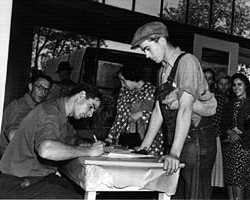
Where do you find those historical images? We’ll suggest three resources that will help link you to a variety of collections of photos and images.
1. Wikipedia “Public Domain Image Resources” stored on Wikimedia Common
This site offers “... the largest free images only repository and it contains many public domain images.” It offers links to collections of historical images, books including Project Gutenberg and the Google Library Project, general photo collections and government files. The links connect you to over 3.5 million images.
2. About.com “Historic Photos & Photo Collections”
The site helps you “discover thousands of free historic photos for use in your family history projects in these online collections of digitized historic photos and portraits.”
It contains links to 30 image collections. I have used several including the Library of Congress American Memory Collection, the BYU Historical Photograph Collection, UC Berkeley California Heritage Collection and the San Francisco Public Library’s Photograph Collection. All of them are excellent.

3. University of Houston Digital History
The site offers links to collections with images of topics including: Advertisements, African Americans, Architecture, Art Books and Pamphlet Images Canada, Civil War, Daguerreotypes, Ethnicity, Federal Government Images, Holocaust, Maps, Medicine, Music, Paintings, Photography, New deal, Political History, Portraits, Radicalism, Science and Technology, Slavery, Southwest, States, Trials and Court Cases, World War I, and World War II.
If you are looking for images to illustrate a book it’s likely that one of these sites will guide you to them.
